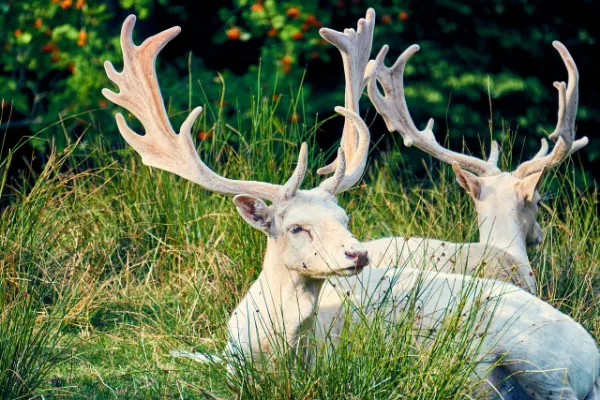In the heart of North America’s forests and fields, a ghostly figure sometimes emerges—a snow-white deer with pink eyes, pale hooves, and an aura of mystery. These elusive creatures, known as albino deer, captivate wildlife enthusiasts, hunters, and photographers alike. But beyond their striking appearance lies a rich story of genetics, survival challenges, and cultural symbolism.
What Is an Albino Deer?
Albino deer are white-tailed deer or mule deer that exhibit a genetic condition called albinism, a rare mutation that affects melanin production. Melanin is the pigment responsible for coloration in skin, hair, and eyes. In albino animals, a complete absence of melanin results in:
- Pure white fur
- Pinkish or light-blue eyes
- Pink nose and hooves
- Extreme sensitivity to sunlight
This condition is not to be confused with leucism, a different genetic condition that also causes pale coloring but allows for some pigment retention, especially in the eyes and hooves.
How Rare Are Albino Deer?
Albino deer are exceptionally rare, with estimates suggesting they occur in only 1 in 20,000 to 1 in 30,000 wild deer births. Their rarity makes them a sought-after sight for wildlife watchers and a frequent subject of online folklore and urban legends. Some states in the U.S. even offer protection to these rare animals, considering them biologically unique and culturally valuable.
The Genetics Behind Albinism
Albinism in deer is caused by a recessive gene. For a fawn to be born albino, both parents must carry the gene, even if neither displays the trait themselves. This makes inheritance of the condition statistically unlikely, which contributes to its rarity in wild populations.
Albino deer can also suffer from genetic weaknesses associated with inbreeding if populations are isolated or if the gene pool is small.
Survival Challenges in the Wild
Although albino deer are mesmerizing to look at, they face a number of disadvantages in the wild:
- Camouflage Deficit
The white coat stands out against the natural greens and browns of the forest, making albino deer easy targets for predators such as coyotes, wolves, and humans. - Vision Problems
Many albino animals suffer from poor eyesight due to abnormal development of the retina and optic nerves. This can impair their ability to spot predators or navigate their environment. - Skin Sensitivity
Without melanin, their skin and eyes are vulnerable to damage from UV rays, leading to potential long-term health problems. - Shorter Lifespan
Due to these compounded vulnerabilities, albino deer often have shorter life spans than their pigmented counterparts.

Cultural and Spiritual Significance
Throughout history, white deer have held special meaning in various cultures:
- Native American Tribes often regarded white deer as sacred messengers or omens, symbols of purity and a bridge between the physical and spiritual worlds.
- Celtic Mythology viewed white stags as harbingers of a mystical quest or as guides to other realms.
- In modern folklore, sighting an albino or white deer is often seen as a good omen, a sign of good fortune, or a spiritual awakening.
Because of these deep-rooted beliefs, some communities have laws or traditions that forbid the hunting of albino deer altogether.
Where Are Albino Deer Found?
Albino deer have been reported across North America, particularly in states such as:
- Wisconsin (where the town of Boulder Junction claims to be the “Home of the White Deer”)
- Michigan
- Texas
- Pennsylvania
Certain protected populations, especially in isolated or urbanized environments, have allowed albino deer to thrive without natural predation.
Conservation and Legal Protections
Because of their rarity and cultural significance, several states have enacted laws to protect albino deer from hunting. For example:
- Illinois and Iowa have had restrictions in place to safeguard albino deer.
- Tennessee prohibits the hunting of albino deer entirely.
- In contrast, Wisconsin lifted its albino deer hunting ban in 2008, sparking controversy and debate among conservationists and the public.
The protection—or lack thereof—of these animals remains a contentious issue. While some view them as natural treasures to be preserved, others argue that managing wildlife based on appearance alone sets a problematic precedent.
Albino Deer in Photography and Media
Thanks to the advent of trail cameras and wildlife drones, albino deer have become stars of viral videos and nature photography. Their photogenic appearance and rarity make them a favorite subject for:
- Wildlife documentaries
- Nature blogs
- Local news stories
- Conservation campaigns
Seeing one in the wild is often described as a “once-in-a-lifetime” experience, and many who have had the opportunity describe it as deeply moving or even spiritual.
Final Thoughts: A Living Symbol of Nature’s Mystery
Albino deer are more than just a visual anomaly—they are a vivid reminder of the complexity and wonder of the natural world. Their existence touches on themes of science, survival, mythology, and ethics. As our landscapes continue to change, and as human-wildlife interactions evolve, it’s up to us to decide how we respect and protect such rare and remarkable animals.
Whether you’re a biologist, a photographer, or someone who simply loves the outdoors, spotting an albino deer is a moment to remember—and perhaps, one to treasure.
